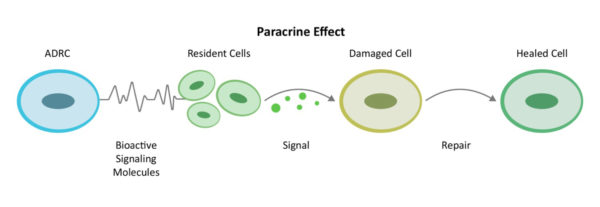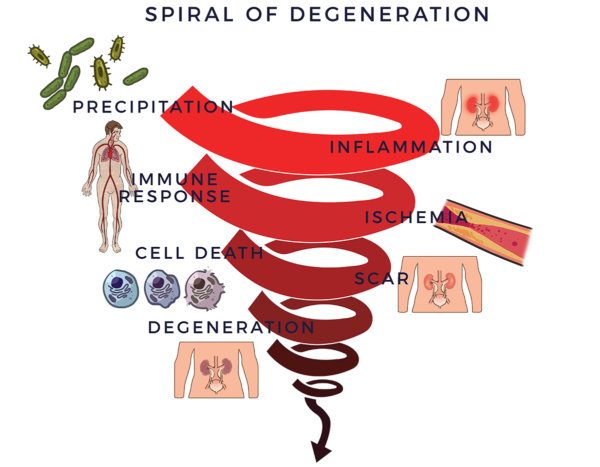AMBROSE-Zelltherapie für Nierenkrankheiten
Wie in einem neuen Forschungsbereich üblich, führte eine Gruppe von Wissenschaftlern 2010 eine Tierstudie durch, um die potenzielle Sicherheit und Wirksamkeit von aus Fettgewebe gewonnenen Stamm- und regenerativen Zellen (ADRCs) zur Behandlung akuter Nierenerkrankungen zu testen.
Die Ergebnisse waren überraschend positiv und zeigten, dass die ADRC-Therapie die Sterblichkeit drastisch reduzierte: 100% der behandelten Mäuse überlebten im Vergleich zu 57%, die ein Placebo erhielten (Kontrollen). Auch die Serumkreatininwerte waren bei den behandelten Mäusen deutlich niedriger als bei den Kontrollen.[1] Seit dieser Studie haben eine Reihe weiterer Studien über akute und chronische Nierenerkrankungen bei kleinen und großen Tieren sowie beim Menschen gezeigt, dass adulte Stammzellen und andere regenerative Zellen aus Fettgewebe möglicherweise dazu beitragen können, das Fortschreiten der Krankheit zu verhindern, den Kreatininspiegel im Serum zu senken, die fibröse Narbe (Fibrose) rückgängig zu machen und den Blutfluss zu verbessern.[2] [3] [4] Studien am Menschen haben ebenfalls gezeigt, dass sich die Nierenfunktion nach einer Stammzellenbehandlung verbessert hat.[5]
Aus Fettgewebe stammende Stamm- und regenerative Zellen (ADRCs)
Körperfett, medizinisch als Fettgewebe bezeichnet, ist eine attraktive Quelle für Stamm- und regenerative Zellen, da es im Vergleich zu anderen Gewebequellen wie Knochenmark, Nabelschnur und Plazenta leicht zugänglich, reichlich vorhanden und wirksam ist. ADRCs können am selben Tag entnommen, aufbereitet und am Krankenbett wieder injiziert werden. Durch ihre vielfältigen biologischen Aktivitäten konnten sie bereits zur Verbesserung der Symptome, der Funktion und der Lebensqualität bei einer Vielzahl von Erkrankungen, einschließlich akuter und chronischer Nierenerkrankungen, eingesetzt werden.[6] [7]
Spirale der Degeneration
Chronische degenerative Erkrankungen, einschließlich Nierenversagen, folgen einem ähnlichen Muster in ihrem Krankheitsverlauf.
Ein Trauma, eine Infektion, Umweltgifte, ungesunde Lebensgewohnheiten (z. B. Rauchen), erbliche Faktoren oder eine Kombination dieser negativen Faktoren können eine Entzündungsreaktion auslösen. Diese Art von Entzündung (akut) ist für die Reparatur des Körpers unerlässlich und ist in der Regel nur von kurzer Dauer und verschwindet, sobald der Heilungsprozess stattgefunden hat.
Es gibt noch eine andere Art von anhaltender Entzündungsreaktion, die chronisch wird und den gesamten Körper betrifft und systemisch wird.[8] Systemische Entzündungen sind ein häufiger Faktor bei Alterskrankheiten. Sie umfassen ein breites Spektrum schwerer, schwächender und manchmal lebensbedrohlicher Erkrankungen, zu denen auch Nierenversagen gehört.[9] [10]
Bei degenerativen Erkrankungen setzt die chronische Entzündung einen bösartigen degenerativen Prozess in Gang. Sie rekrutiert das Immunsystem, das zur Bekämpfung von Infektionen und anderen Krankheitsprozessen sowie zur Unterstützung der Heilung da ist. Die Zellen des Immunsystems (Immunzellen) haben die Aufgabe, den Körper zu schützen. Wenn sie einen Feind wahrnehmen, senden sie Truppen entzündungsfördernder Moleküle, so genannter “Zytokine”, aus, um ihn zu bekämpfen. Wenn dieser Prozess außer Kontrolle gerät, spricht man von einer entzündlich-immunen Reaktion. Diese Reaktion ist gleichbedeutend mit einem Rücksitzfahrer, der chronisch überreagiert, während er Ihnen beim Autofahren “hilft”. Die Immunreaktion führt dann zu einem verminderten Blutfluss (Ischämie). Ohne gute Durchblutung sterben Zellen ab, es bilden sich Narben und Fibrosen, Gewebe und Organe degenerieren. Wir nennen dies die Degenerationsspirale, da wir sie als Rahmen für das Verständnis einiger Schlüsselfaktoren der Nierenerkrankung verwenden.
Der Verlust der Nierenfunktion geht mit einer Entzündung einher, die das Filtersystem der Nieren und ihre kleinen Blutgefäße betrifft. Es ist bekannt, dass chronische Nierenerkrankungen mit Diabetes und unkontrolliertem Bluthochdruck einhergehen, wodurch sich die Nierenfunktion mit der Zeit allmählich verschlechtert. In den frühen Stadien treten in der Regel keine Symptome auf. Eine akute Nierenerkrankung kann schnell durch einen unzureichenden Flüssigkeitsstatus (aufgrund einer Vielzahl von Erkrankungen) und durch bestimmte Medikamente ausgelöst werden.
Prozess der Reparatur
Durch einen Mechanismus der Zell-zu-Zell-Kommunikation, der als parakriner Effekt bekannt ist, mobilisieren ADRCs Zellen in der Nähe, um effizienter zu arbeiten. Sie rekrutieren die biologischen Feuerwehr-, Rettungs- und Reparaturabteilungen am Ort des Geschehens - die ansässigen Stammzellen -, damit sie ihre Arbeit wieder aufnehmen und ihren Beitrag leisten können.

ADRCs rekrutieren zusätzliche "Reparateure" am Ort des Geschehens (ortsansässige Stammzellen), die sich wieder an die Arbeit machen und ihren Teil dazu beitragen, ein erweitertes Team zusammenzustellen und zunächst Entzündungen und überaktive Immunreaktionen zu verringern. Sobald die Rückwärtsfahrt nachlässt, setzen sie ihre Arbeit fort, indem sie die Durchblutung durch das Wachstum neuer Blutgefäße steigern, weiteren Zelltod verhindern, Narbengewebe bekämpfen und gesundes Gewebe und Nerven regenerieren. Auf diese Weise heilt der Körper auf natürliche Weise, aber wenn die Beeinträchtigung durch eine akute oder chronische Erkrankung zu groß ist, braucht er Hilfe.
Wir nennen dies den Prozess der Reparatur. Er umfasst die vielfältigen Wirkmechanismen, die erforderlich sind, um die systemische Entzündung und die Immunantwort wieder ins Gleichgewicht zu bringen.
AMBROSE-Zelltherapie für Nierenkrankheiten
Da die primären Faktoren in der oben beschriebenen Spirale bei Nierenversagen eine Rolle spielen und die vielfältigen Reparaturmechanismen der ADRCs diese Effekte bei dieser und einer Reihe anderer schwerer Erkrankungen nachweislich umkehren können, können Patienten mit Nierenerkrankungen potenziell von der AMBROSE-Zelltherapie profitieren.
Tierstudien haben gezeigt, dass Stammzellen akute Nierenverletzungen reduzieren, indem sie spezialisierte weiße Blutkörperchen aktivieren, die die Heilung und die Reparatur des Nierengewebes einleiten und vor vorzeitiger Zellalterung schützen.[11] [12] [13]
Ebenso hat sich gezeigt, dass die Behandlung von chronischen Nierenerkrankungen mit Stammzellen bei Tieren die Wiederherstellung der Energieproduktion der Nierenzellen fördert.[14] [15], Narbenbildung verringern[16], und verringern Entzündungen.[17]
Die AMBROSE-Zelltherapie stellt eine minimal-invasive Behandlungsoption für Patienten mit Nierenerkrankungen dar. Bitte kontaktieren Sie uns, wenn Sie weitere Informationen über die Behandlung, die Eignung und die Möglichkeit, Patient zu werden, wünschen.
[1] Z Feng et al. Frische und kryokonservierte, nicht kultivierte, aus Fettgewebe gewonnene Stamm- und regenerative Zellen verbessern die durch Ischämie-Reperfusion verursachte akute Nierenschädigung, Nephrologie Dialyse Transplantation, Band 25, Ausgabe 12, 1. Dezember 2010, Seiten 3874-3884
[2] C. Donizetti-Oliveira: Behandlung mit aus Fettgewebe gewonnenen Stammzellen verhindert das Fortschreiten der Nierenerkrankung Cell Transplantation, Vol. 21, pp. 1727-1741, 2012
[3] A Eirin et al Adipose tissue-derived mesenchymal stem cells improve revascularization outcomes to restore renal function in swine atherosclerotic renal artery stenosis Stem Cells. 2012 May; 30(5): 1030-1041
[4] JJ Rivera-Valdés et al. (2017) Human adipose derived stem cells regress fibrosis in a chronic renal fibrotic model induced by adenine. PLoS ONE 12(12)
[5] El-Ansary M, Saadi G, Abd El-Hamid SM. Mesenchymale Stammzellen sind ein Rettungsansatz zur Wiederherstellung einer sich verschlechternden Nierenfunktion. Nephrologie 2012;17:650-657.
[6] Guo et al. Stromale Gefäßfraktion: A regenerative reality? Teil 2: Aktuelle Konzepte und Überblick über die Literatur Journal of Plastic, Reconstructive & Aesthetic Surgery (2016) 69, 180e188
[7] JK Fraser PhD und S Kesten MD Autologe, aus Fettgewebe gewonnene regenerative Zellen: Eine Plattform für therapeutische Anwendungen Fortgeschrittene Wundheilung Surgical Technology International XXIX
[8] S. Amor Entzündung bei neurodegenerativen Erkrankungen Immunologie, 129, 154-169
[9] C. Franceschi und J. Campisi Chronische Entzündung (Inflammaging) und ihr potenzieller Beitrag zu altersassoziierten Krankheiten J Gerontol A Biol Sci Med Sci 2014 June;69(S1): S4-S9
[10] Suliman ME, Stenvinkel P. Contribution of Inflammation to Vascular Disease in Chronic Kidney Disease Patients. Saudi J Kidney Dis Transpl 2008;19:329-45
[11] Geng, Y.; Zhang, L.; Fu, B.; Zhang, J.; Hong, Q.; Hu, J.; Li, D.; Luo, C.; Cui, S.; Zhu, F.; et al. Mesenchymal stem cells ameliorate rhabdomyolysis-induced acute kidney injury via the activation of m2 macrophages. Stem Cell Res. Ther. 2014, 5, 80
[12] Lee, S.J.; Ryu, M.O.; Seo, M.S.; Park, S.B.; Ahn, J.O.; Han, S.M.; Kang, K.S.; Bhang, D.H.; Youn, H.Y. Mesenchymale Stammzellen tragen zur Verbesserung der Nierenfunktion in einem Nierenverletzungsmodell für Hunde bei. In Vivo 2017, 31, 1115-1124
[13] Rodrigues, C.E.; Capcha, J.M.; de Braganca, A.C.; Sanches, T.R.; Gouveia, P.Q.; de Oliveira, P.A.; Malheiros, D.M.; Volpini, R.A.; Santinho, M.A.; Santana, B.A.; et al. Humane mesenchymale Stromazellen aus der Nabelschnur schützen vor vorzeitiger Nierenseneszenz infolge von oxidativem Stress bei Ratten mit akuter Nierenverletzung. Stem Cell Res. Ther. 2017, 8, 19
[14] Yoon, Y.M.; Han, Y.S.; Yun, C.W.; Lee, J.H.; Kim, R.; Lee, S.H. Pioglitazone protects mesenchymal stem cells against p-cresol-induced mitochondrial dysfunction via up-regulation of pink-1. Int. J. Mol. Sci. 2018, 19, 2898
[15] Lira, R.; Oliveira, M.; Martins, M.; Silva, C.; Carvalho, S.; Stumbo, A.C.; Cortez, E.; Verdoorn, K.; Einicker-Lamas, M.; Thole, A.; et al. Transplantation of bone marrow-derived mscs improves renal function and na(+)+k(+)-atpase activity in rats with renovascular hypertension. Cell Tissue Res. 2017, 369, 287-301
[16] Wu, H.J.; Yiu, W.H.; Li, R.X.; Wong, D.W.; Leung, J.C.; Chan, L.Y.; Zhang, Y.; Lian, Q.; Lin, M.; Tse, H.F.; et al. Mesenchymal stem cells modulate albumin-induced renal tubular inflammation and fibrosis. PLoS ONE 2014, 9, e90883
[17] Abdel Aziz, M.T.; Wassef, M.A.; Ahmed, H.H.; Rashed, L.; Mahfouz, S.; Aly, M.I.; Hussein, R.E.; Abdelaziz, M. The role of bone marrow derived-mesenchymal stem cells in attenuation of kidney function in rats with diabetic nephropathy. Diabetol. Metab. Syndr. 2014, 6, 34



